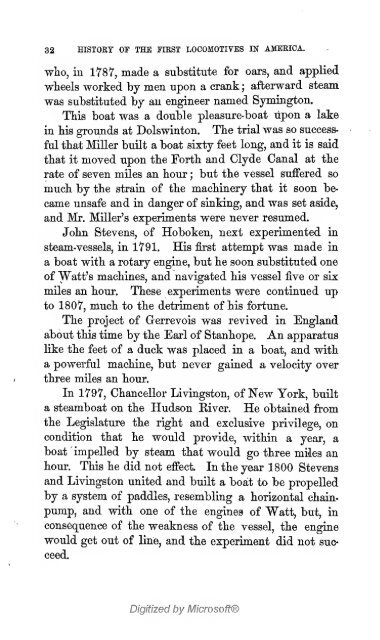The history of the first locomotives in America. From original ...
The history of the first locomotives in America. From original ...
The history of the first locomotives in America. From original ...
You also want an ePaper? Increase the reach of your titles
YUMPU automatically turns print PDFs into web optimized ePapers that Google loves.
32 HISTOEY OF THE FIKST LOCOMOTIVES Ilf AMEEIOA.<br />
who, <strong>in</strong> 1787, made a substitute for oars, and applied<br />
wlieels worked by men upon a crank ;<br />
afterward steam<br />
was substituted by an eng<strong>in</strong>eer named Sym<strong>in</strong>gton.<br />
This boat was a double pleasure-boat upon a lake<br />
<strong>in</strong> kis grounds at Dolsw<strong>in</strong>ton, <strong>The</strong> trial was so success-<br />
ful that Miller built a boat sixty feet long, and it is said<br />
that it moved upon tke Fortk and Clyde Canal at tke<br />
rate <strong>of</strong> seven miles an hour ; but <strong>the</strong> vessel suffered so<br />
much by <strong>the</strong> stra<strong>in</strong> <strong>of</strong> <strong>the</strong> mach<strong>in</strong>ery that it soon became<br />
unsafe and <strong>in</strong> danger <strong>of</strong> s<strong>in</strong>k<strong>in</strong>g, and was set aside,<br />
and Mr. Miller's experiments were never resumed.<br />
John Stevens, <strong>of</strong> Hoboken, next experimented <strong>in</strong><br />
steam-vessels, <strong>in</strong> 1791, His <strong>first</strong> attempt was made <strong>in</strong><br />
a boat with a rotary eng<strong>in</strong>e, but he soon substituted one<br />
<strong>of</strong> Watt's mach<strong>in</strong>es, and navigated his vessel five or six<br />
miles an hour. <strong>The</strong>se experiments were cont<strong>in</strong>ued up<br />
to 1807, much to <strong>the</strong> detriment <strong>of</strong> his fortune.<br />
<strong>The</strong> project <strong>of</strong> Gerrevois was revived <strong>in</strong> England<br />
about this time by <strong>the</strong> Earl <strong>of</strong> Stanhope. An apparatus<br />
like <strong>the</strong> feet <strong>of</strong> a duck was placed <strong>in</strong> a boat, and with<br />
a powerful mach<strong>in</strong>e, but never ga<strong>in</strong>ed a velocity over<br />
three miles an hour.<br />
In 1797, Chancellor Liv<strong>in</strong>gston, <strong>of</strong> New York, built<br />
a steamboat on <strong>the</strong> Hudson River. He obta<strong>in</strong>ed from<br />
<strong>the</strong> Legislature <strong>the</strong> right and exclusive privilege, on<br />
condition that he would provide, with<strong>in</strong> a year, a<br />
boat impelled by steam that would go three miles an<br />
hour. This he did not effect. In <strong>the</strong> year 1800 Stevens<br />
and Liv<strong>in</strong>gston united and bijilt a boait to be propelled<br />
by a system <strong>of</strong> paddles, resembl<strong>in</strong>g a horizontal cha<strong>in</strong>pump,<br />
and with one <strong>of</strong> <strong>the</strong> eng<strong>in</strong>es <strong>of</strong> Watt, but, <strong>in</strong><br />
consequence <strong>of</strong> <strong>the</strong> weakness <strong>of</strong> <strong>the</strong> vessel, <strong>the</strong> eng<strong>in</strong>e<br />
would get out <strong>of</strong> l<strong>in</strong>e, and <strong>the</strong> experiment did not suc-<br />
ceed.<br />
Digitized by Micros<strong>of</strong>t®
















